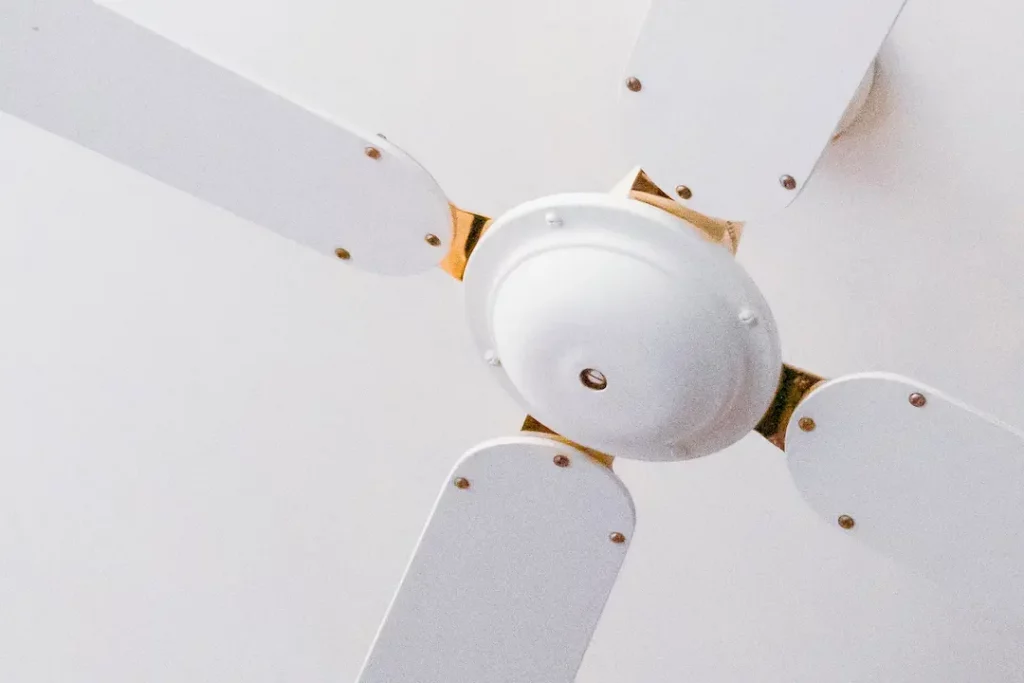
How to Install a Ceiling Fan
Ceiling fans provide air circulation that keeps your home cooler while reducing your energy bills. So living in North Carolina, they're basically a must-have feature! If you want to learn how to install a ceiling fan or change out your existing fan, it can be a bit more challenging than you may realize. Read through this step-by-step guide to how to install a ceiling fan safely - and if it looks to be too much, you can always hire an electrician near you!

Our experienced ceiling fan installation contractors have all of the tools and knowledge to quickly, efficiently, and safely install a ceiling fan for you. However, if you are feeling like you want to try your hand at home improvement projects, installing a ceiling fan can be an easy DIY job when you know the steps to take to complete the installation process.
Choosing the Right Ceiling Fan
First, you need to make sure you're choosing the right fan for the space so you get the proper airflow and aesthetic appeal. First, choose the right size by finding the room's square footage by multiplying the length of the room by the width (a 12 x 14-foot room would be 168 square feet).
- Less than 75 square feet - Choose a fan blade width less than 36 inches wide;
- 75-200 square feet - 36" - 42" fan
- 200+ square feet - 50" - 54" fan
Also, the amount of airflow the fan moves, measured in cubic feet per minute (CFM) plays an important role. Choose a fan with a higher CFM for its class to ensure improved efficiency, optimal cooling, and quieter operation.
Selecting Where to Install a Ceiling Fan
With your fan selected, now you need to know where you will put it. If you have an existing fixture you're replacing, this is probably ideal, but you'll want to consider a few factors to ensure safety and performance.
- Place the fan so the blades are a minimum of 7 feet above the floor, or 8-9 feet for optimal performance.
- Ensure the blades are at least 8 to 10 inches below the ceiling;
- Measure for at least 18 inches of clearance from the edge of the fan blade to any walls, door frames, cabinets, posts, or pillars;
- If you have can lights or other ceiling light fixtures, make sure the blades won't be below them as it can cause a continual flickering.
When you have a place in mind, check the ceiling to make sure it's in excellent condition with no damage.
Prepare the Room to Install Your Ceiling Fan
Once you’ve chosen the room to install your ceiling fan in, you need to make sure that your surroundings are clear of any objects or distractions that could stop you from getting the job done right. If the room needs to be cleaned before bringing your ladder in, now is the time to do that. It’s important to make sure, whenever using a ladder and tools, that the surrounding floor is free from places you can slip, fall, or hurt yourself.
Prepare the Ceiling for Ceiling Fan Installation
Before you remove the existing lighting fixture or ceiling fan, turn off the electricity in the room so you do not shock yourself. If you need to learn how to remove a ceiling fan, check out this article. Once you know exactly where the ceiling fan is going to be installed, it’s time to prepare the ceiling for installation.
If there was a pre-existing fan or lighting fixture there prior, you will want to make sure that the existing electrical components are working properly by testing wall switches. However, if you do not already have wiring, switches, or electricity running to the location you plan to install your ceiling fan, you will need to contact a professional electrician who has experience running an electrical cable to the desired location of the ceiling.
Safely Preparing for Ceiling Fan Installation
A ceiling fan can weigh anywhere between 15 to 50 pounds, so it’s vital that your ceiling fan is properly mounted to a stable ceiling that has the proper support joints to hold the weight. Safety is of the utmost importance, so if you are unsure of the ceiling’s structural integrity or worried about working closely with electrical circuits, our licensed residential electricians can install your fan for you.
How to Install a Ceiling Fan
Once all of the preparation and precautionary steps are out of the way, it's time to actually install the ceiling fan.
Step 1: Shut Down Electrical Currents Before Installing a Ceiling Fan
Okay, just doubling down on safety yet again! When doing home improvement projects of any kind– but particularly when doing ones that include electrical wiring– power down the electricity for the circuit you are working on. Failing to do this could lead to potential electrocution.
Step 2: Assemble the Ceiling Fan Components
Laying the fan on a flat surface on the floor or a table, feed the wires from the center of the canopy so that the fan motor can be attached and the downrod– the elongated part of the fan that extends the length from the ceiling down to the actual bladed fan itself– can be attached. Thread the pipe of the downrod into the top of the motor, and secure by tightening all screws.
Step 3: Install the Mounting Bracket and Junction Box
After confirming that the electricity to the room has been shut down, it’s time to mount your electrical box and mounting bracket to the ceiling for the installation of your ceiling fan.
Sometimes, the mounting bracket arrives pre-attached to the fan’s canopy. The canopy is the decorative cover for the interior components of the fan. If the canopy and bracket are pre-attached, detach them. Now, the mounting bracket needs to be attached to the junction box using the screws that came with your ceiling fan. The electrical supply wires should be pulled to hang down through the opening of the mounting bracket.
Step 4: Install the Ceiling Fan
With the old fan down, the proper support in place, and an electrical box installed if necessary, you're ready to install the ceiling fan to the ceiling. Remember, at this point, the blades should not be on your ceiling fan. You'll connect those at the end.
To connect the ceiling fan wiring:
- Thread the wires from the motor down through the housing, trim wiring, and canopy. If there's a downrod, run them into the downrod ball, keeping them on one side of the pin.
- Attach the top housing, trim ring, and canopy to the fan motor. Insert the downrod, if applicable, into the collar of the fan motor.
- Cut and strip the wires;
- Your mounting bracket may have a hook or hanger ball, making installation much easier. Otherwise, have a buddy hold the fan while you continue the ceiling fan installation.
- Use wire connectors to connect the wires, taking care to follow the directions that came with the fan. Make sure there are no bare wires or wire filaments outside the wire connector with the exception of the ground wire, which should be bare or green. Secure the connectors with electrical tape.
- Tuck the wires into the electrical box, keeping green and white wires on one side and black on the other.
Step 5: Attach the Canopy and Blades
With the fan properly wired, you can then attach the canopy to the mounting bracket using the screws that came with the fan. After that, attach the ceiling fan blades. Start all screws, then go around and tighten them. To avoid wobbling, balance the fan by tightening the screws that secure the blades to the brackets or ensure the box is properly secured to the ceiling joist. In just a few steps you’ve managed to install your new ceiling fan.
Call Us for Ceiling Fan Installation in Durham Today
Instead of spending hours on a ladder trying a DIY project, call the experienced electrical contractors at MSS-Ortiz for ceiling fan installation in Durham. While our headquarters is in Durham, we serve Raleigh, Greensboro, Cary, Apex, Pittsboro, and surrounding areas.
We can have your new fan installed quickly, safely, and correctly, saving you time and stress. Call us today at (919) 382-0832 for a quote or to schedule service, or fill out the contact form below to get started.

